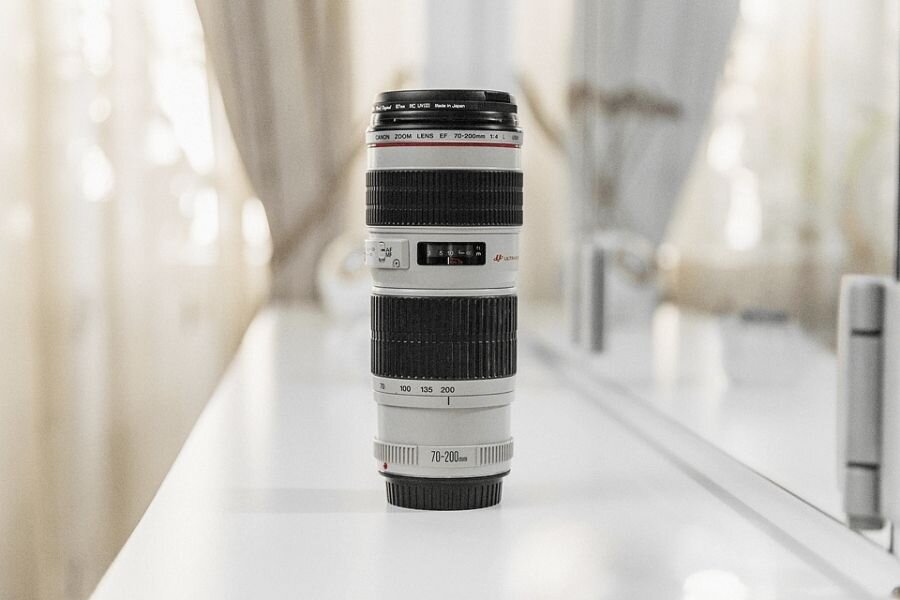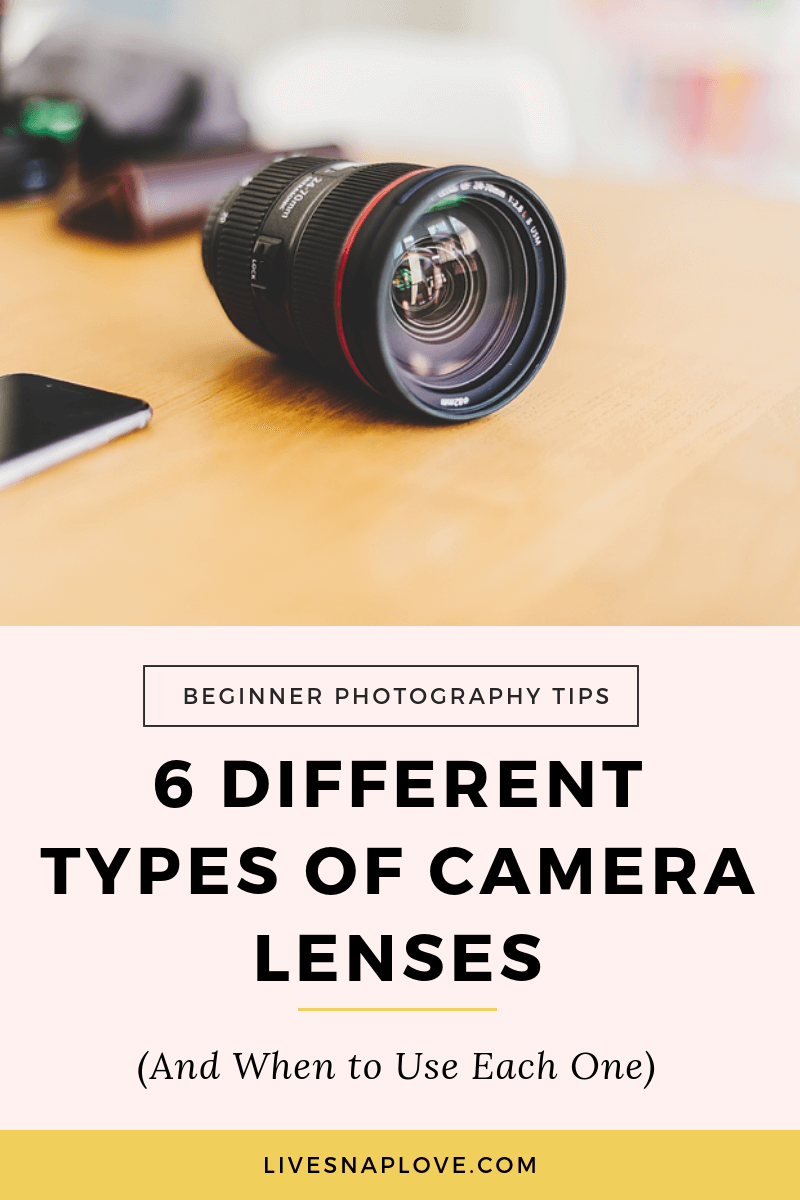6 Different Types of Camera Lenses (and when to use each one)
One of the things that used to REALLY confuse me when I first started learning photography was all the different types of camera lenses that were available, which one I would need, and when I would use each one!
So as I’m willing to bet this bamboozles you too, I’ve put together this post that should make it all seem a damn sight easier to understand.
It breaks down the different types of lenses you can get, the variations you can find within that, along with suggestions for when you would use each one.
Let’s dig in…
#1 - Standard Lenses
Let's kick things off with STANDARD lenses.
Standard lenses have a mid-range focal length, somewhere around 50mm - but really anything between 40mm and 60mm. The most common focal length is the one that falls slap bang in the middle of that - the 50mm.
This focal length on a full frame camera will give you roughly the same field of view as the naked eye - It’s not exact, but it’s a pretty good rule of thumb. Basically this means when you lift that camera to your eye, the scene won’t seem “zoomed in” or “zoomed out”, so it will look quite natural, and have no distortion.
So, when would you use a standard lens?
These are great all rounders, mainly because they most closely mimic what we can see naturally, so you don’t have to worry about it being the “wrong” lens for the job. Some concrete examples would be:
Portraits
Street Photography
Indoor Photography
Landscape Photography
That doesn’t mean it is the “ideal” lens for any of these (in most cases, you will get other lenses that can do the above better) but rather that if you only want one lens that can adequately cover a full range of situations, a standard lens is your best bet
If you go with a prime 50mm lens, one of other the big plus points is they aren’t usually too big or too heavy (they are juuuuust right) which means they are great to throw in your bag for a walkabout lens, or to take with you when you go on holiday.
#2 Telephoto Lenses
Telephoto lenses have a LONGER focal length, and they magnify the subject, allowing you to take photos of subjects that are farther away.
Generally, a lens is considered telephoto with a focal range above 60mm, but you can probably further categorise a telephoto range into a “mid-range” telephoto which is around 70mm to 200mm, and then “super-telephoto” which is anything over 200m, like a 300mm or 400mm. (aka Paparazzi stalking territory)
When would you use a telephoto lens?
Because they can be quite cramped indoors, you are best to use a telephoto lens outside, especially when you have some distance between you and your subject.
They are also incredibly flattering for portraits, as they slim down the face ever so slightly, and give great background blur, helping separate your subject from the background.
(You know those images that look like their subject is "popping" off the background? That's usually down to using a telephoto)
You’ll also use these for times when you simply can’t get too close to your subject, such as for shooting wildlife or sports.
So here are some areas where a telephoto lens is damn useful:
Portrait Photography (particularly mid-range telephoto)
Wildlife photography
Sports Photography
Astronomy
Where you want dreamy background blur
As the focal length goes up, so does the weight and size of the lens, so at the far end of the super telephoto range, you are going to need to use a tripod, or seriously increase your gym workouts. As a result, they are not that great for going on a long walkabout with, as they can get really heavy very quickly, and they can be cumbersome - especially if you have a zoom telephoto.
#3 Wide Angle Lenses
Wide angle lenses are the exact opposite of telephoto lenses, as with these you can fit MORE into the frame than a standard lens - in other words, everything looks zoomed out.
The focal length for a wide angle is pretty much anything below 40mm.
The smaller that focal length number, the more you will be able to fit into the frame, but also keep in mind that the more you fit in the frame, the more distortion you are likely to get.
Also, any lens with a focal length less than 20mm is generally referred to as a fisheye lens, which gives you an almost 180 degree field of vision (making it look like you are taking an image from inside a fishbowl - hence the term!)
Because of the distortion you can get, wide angles aren’t particularly great for individual portraits, but they can be fab for group photos, or for lifestyle and environmental shots.
When would you use a wide angle lens?
Anytimes when you need to fit more into the frame - so cramped interiors, or large group shots, or to include a whole landscape.
They also help you give a more inclusive feel to an image - in other words where you want the viewer to feel as if they were standing right in the scene when they look at the photo.
Some concrete examples of when you might want to use a wide angle:
Landscapes
Interiors
Large group photos
Lifestyle / Documentary images
Street Photography
Architecture
For an inclusive feel
As a general rule, if you go for a prime lens for your wide angle lens, they are also fairly small and lightweight, so they make a great walkabout lens.
For some more information about which lens to use when, along with more information on lenses in general, be sure to check out the Ultimate Guide to Camera Lenses - it’s just $9 and will save you a ton of time and frustration when it comes to lenses!
#4 Macro Lenses
Macro lenses are for close up photography. They have a 1:1 ratio, which basically means they can capture your subject at life size magnification.
So if you want to capture the teeny tiny little details of a flower, an insect or water droplets (or the details of anything else for that matter) then you’ll need a macro lens.
That doesn’t mean you can ONLY use your macro lens for close up photography - the longer focal length and excellent sharpness and contrast means that they take supremely beautiful portraits too. My macro lens gets used for both in equal measures making it a good all round purchase (or so I keep telling my husband)
When would you use a macro lens?
Nature photography
Insect photography
Portrait Photography
Detail photography (eg ring shots if you shoot weddings)
You can learn more about macro lenses, and how to choose one in this macro lens buying guide (along with some cheaper suggestions in case you don’t want to spend all your $$$ on a dedicated macro lens)
#5 Prime Lenses
Once you have an idea of the focal ranges of the different types of camera lenses, you then need to decide whether you are going for a fixed prime lens, or a zoom lens.
Primes lenses are those that have a fixed focal length such as 35mm, 50mm, 85mm, 135mm and so on. They do not zoom in or out, so you have to physically move yourself closer or farther away from your subject.
They generally can shoot a lower apertures, such as F1.8 or F2.0, and therefore are great lenses for letting in more light, and also for creating background blur, especially if you have a telephoto lens.
Finally, prime lenses tend to give you sharper images, and better overall image quality than zoom lenses.
#6 Zoom Lenses
Zooms allow you to change through the whole focal range of the lens, just by turning the barrel, so you can zoom in and out to fill more or less of the screen.
You can get either get a variable aperture zoom, where the maximum aperture will change whether you are zoomed in or out, or fixed aperture zoom lenses, where you can stay at the same aperture throughout the focal range.
The benefits of a zoom is simply that you can get multiple focal lengths in one handy dandy lens! This means they can be great if you only want one lens, and they can useful for shooting things like weddings, or sports, when you might need to zoom in or out and can’t necessarily get up off your seat to do it!
The downsides is that they tend to more expensive, heavier to carry, and don't have quite the same image quality as you get from primes.
As you can see there are pros and cons to both primes and zooms, so to get a better idea of which is best for you, cast your eye over this earlier post Zooms vs Primes to get more explanation of the differences between the two, and what to think about when making your decision.
So there you have it, 6 different types of camera lenses, and when you would use each one!
NOW I’D LOVE TO HEAR FROM YOU!
In the comments below, answer one or both of these questions:
First, which of these focal lengths do you find yourself hankering after, and why?
Second, what do you prefer to use - a zoom or a prime?
Sharing your insight and inspiration might just help someone else find their own perspective on which lens is best for them, so don’t hold back :) Plus I always love to hear from you!
As always, if you enjoyed this post, or think that others may benefit from it, please share! Either pin to your Pinterest boards, or share on Facebook or Twitter. Sharing helps keeps blogs alive, so thanks if you do xx







